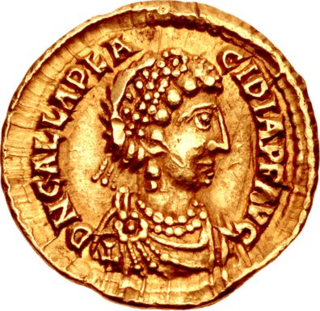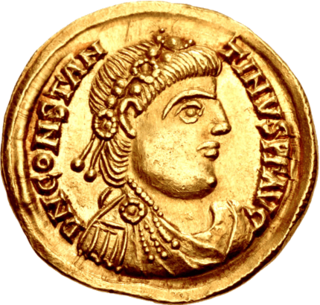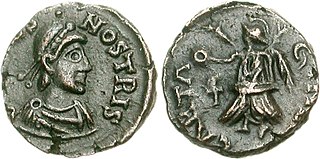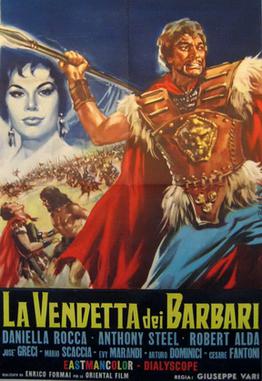Sources
- Jaques, Tony (2007). Dictionary of Battles and Sieges: F-O. Greenwood Publishing Group. ISBN 978-0313335389.
| Siege of Massilia | |||||||
|---|---|---|---|---|---|---|---|
| |||||||
| Belligerents | |||||||
| Visigoths | Western Roman Empire | ||||||
| Commanders and leaders | |||||||
| Ataulf | Bonifacius | ||||||
| Strength | |||||||
| Unknown | Unknown | ||||||
| Casualties and losses | |||||||
| Unknown | Unknown | ||||||
The siege of Massilia was made by the Visigoths against the Roman city of Massilia, Gallia Narbonensis in 413. Campaigning in southern Gaul, the Visigothic king Ataulf had taken Toulouse and Narbonne and laid siege of Massilia. The city was defended by the capable Roman general Bonifacius. Ataulf failed to take Massilia, and later made peace with Emperor Honorius. Marrying Honorius' sister Galla Placidia. Ataulf was thereafter sent to recover Hispania for the empire.

Honorius was Roman emperor from 393 to 423. He was the younger son of emperor Theodosius I and his first wife Aelia Flaccilla. After the death of Theodosius in 395, Honorius, under the regency of Stilicho, ruled the western half of the empire while his brother Arcadius ruled the eastern half. His reign over the Western Roman Empire was notably precarious and chaotic. In 410, Rome was sacked for the first time in almost 800 years.

Galla Placidia, daughter of the Roman emperor Theodosius I, was a mother, tutor, and advisor to emperor Valentinian III. She was queen consort to Ataulf, king of the Visigoths from 414 until his death in 415, briefly empress consort to Constantius III in 421, and managed the government administration as a regent during the early reign of Valentinian III until her death.

Year 410 (CDX) was a common year starting on Saturday of the Julian calendar. At the time, it was known as the Year after the Consulship of Honorius and Theodosius. The denomination 410 for this year has been used since the early medieval period, when the Anno Domini calendar era became the prevalent method in Europe for naming years.

Year 414 (CDXIV) was a common year starting on Thursday of the Julian calendar. At the time, it was known as the Year of the Consulship of Constantius and Constans. The denomination 414 for this year has been used since the early medieval period, when the Anno Domini calendar era became the prevalent method in Europe for naming years

Year 415 (CDXV) was a common year starting on Friday of the Julian calendar. At the time, it was known as the Year of the Consulship of Honorius and Theodosius. The denomination 415 for this year has been used since the early medieval period, when the Anno Domini calendar era became the prevalent method in Europe for naming years.
The 410s decade ran from January 1, 410, to December 31, 419.

Year 411 (CDXI) was a common year starting on Sunday of the Julian calendar. At the time, it was known as the Year of the Consulship of Theodosius without colleague. The denomination 411 for this year has been used since the early medieval period, when the Anno Domini calendar era became the prevalent method in Europe for naming years.

Year 413 (CDXIII) was a common year starting on Wednesday of the Julian calendar. At the time, it was known as the Year of the Consulship of Herclianus and Lucius. The denomination 413 for this year has been used since the early medieval period, when the Anno Domini calendar era became the prevalent method in Europe for naming years.

Constantine III was a common Roman soldier who was declared emperor in Roman Britain in 407 and established himself in Gaul. He was recognised as co-emperor of the Roman Empire from 409 until 411.

Athaulf was king of the Visigoths from 411 to 415. During his reign, he transformed the Visigothic state from a tribal kingdom to a major political power of late antiquity.

Jovinus was a Gallo-Roman senator and claimed to be Roman Emperor.

Bonifatius was a Roman general and governor of the diocese of Africa. He campaigned against the Visigoths in Gaul and the Vandals in North Africa. An ally of Galla Placidia, mother and advisor of Valentinian III, Bonifacius engaged in Roman civil wars on her behalf against the generals Felix in 427-429 and Aetius in 432. Although he defeated the latter at the Battle of Rimini, Bonifacius suffered a fatal wound and was succeeded by his son-in-law Sebastianus as patricius of the Western Roman Empire.

The Theodosian dynasty was a Roman imperial family that produced five Roman emperors during Late Antiquity, reigning over the Roman Empire from 379 to 457. The dynasty's patriarch was Theodosius the Elder, whose son Theodosius the Great was made Roman emperor in 379. Theodosius's two sons both became emperors, while his daughter married Constantius III, producing a daughter that became an empress and a son also became emperor. The dynasty of Theodosius married into, and reigned concurrently with, the ruling Valentinianic dynasty, and was succeeded by the Leonid dynasty with the accession of Leo the Great.

Sigeric was a Visigoth king for seven days in 415 AD.

Sebastianus, a brother of Jovinus, was an aristocrat of southern Gaul. After Jovinus usurped the throne of the western Roman Emperor Honorius in Gaul in 411, he named Sebastianus as Augustus (co-emperor) in 412. Coins bearing Sebastianus' image were then minted at Arles and Trier.

The Sack of Rome on 24 August 410 AD was undertaken by the Visigoths led by their king, Alaric. At that time, Rome was no longer the administrative capital of the Western Roman Empire, having been replaced in that position first by Mediolanum in 286 and then by Ravenna in 402. Nevertheless, the city of Rome retained a paramount position as "the eternal city" and a spiritual center of the Empire. This was the first time in almost 800 years that Rome had fallen to a foreign enemy, and the sack was a major shock to contemporaries, friends and foes of the Empire alike.
Sarus or Saurus was a Gothic chieftain known as a particularly brave and skillful warrior. He became a commander for the Emperor Honorius. He was known for his hostility to the prominent Gothic brothers-in-law Alaric I and Athaulf, and was the brother of Sigeric, who briefly ruled the Goths in 415.

Revenge of the Barbarians is a 1960 film about the sack of Rome in AD 410 by the Visigoths.
The Battle of Ostia was fought in 409 AD between the Visigoths and the Western Roman Empire. The battle was part of the invasion of Italy by the Visigothic king Alaric I. Having driven the emperor Honorius into Ravenna, Alaric laid siege to Rome. In order to support his siege, Alaric attacked the nearby city of Ostia at the mouth of the Tiber. He took the city port along with a massive amount of food supplies destined for the capital. A year after seizing Ostia, Alaric sacked Rome.
The Battle of Tauroento was a naval battle fought off the coast of Tauroento during Caesar's Civil War. Following a successful naval battle outside Massilia, the Caesarian fleet commanded by Decimus Junius Brutus Albinus once again came into conflict with the Massiliot fleet and a Pompeian relief fleet led by Quintus Nasidius on 31 July 49 BC. Despite being significantly outnumbered, the Caesarians prevailed and the Siege of Massilia was able to continue leading to the eventual surrender of the city.